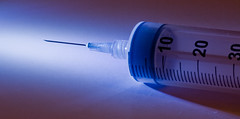Many factors go into the making of an American criminal, but who would have thought that one of them might be lead?
A recent investigative piece by Mother Jones reporter Kevin Drum asserts just that, and it has sparked a wild flurry of debate in the wake of his extensive and damning article.
We all know that many childhood factors can influence a tendency towards crime. Broken homes, exposure to additive substances and many more are often trotted out, and rightfully so. Drum asserts that the ambient lead caused by lead paint and vehicle exhaust are directly linked to crime rates.
Rick Nevin, a consultant working for the US Department of Housing and Urban Development, began finding correlations between the rise and fall of leaded gasoline and urban crime rates. He discovered that they describe almost identical curves, but are 23 years out of synch.
Jessica Reyes, public health policy professor at Amherst, weighs in on the research she did, inspired by being pregnant in a old house and learning about the dangers of lead. What Nevin found on the grand scale she found to also hold true on a more granular level (reporting via Mother Jones) :
If childhood lead exposure really did produce criminal behavior in adults, you’d expect that in states where consumption of leaded gasoline declined slowly, crime would decline slowly too. Conversely, in states where it declined quickly, crime would decline quickly. And that’s exactly what she found.
Meanwhile, Nevin had kept busy as well, and in 2007 he published a new paper looking at crime trends around the world (PDF). This way he could make sure the close match he’d found between the lead curve and the crime curve wasn’t just a coincidence. Sure, maybe the real culprit in the United States was something else happening at the exact same time, but what are the odds of that same something happening at several different times in several countries?
Nevin collected lead data and crime data for Australia and found a close match. Ditto for Canada, Great Britain, Finland, France, Italy, New Zealand and West Germany. Every time the two curves fit each other astonishingly well. When I spoke to Nevin about this, I asked him if he had ever found a country that didn’t fit the theory. “No,” he replied. “Not one.”
Just this year, Tulane University researcher Howard Mielke published a paper with demographer Sammy Zahran on the correlation of lead and crime at the city level. They studied six US cities that had both good crime data and good lead data going back to the ’50s, and they found a good fit in every single one. In fact, Mielke has even studied lead concentrations at the neighborhood level in New Orleans and shared his maps with the local police. “When they overlay them with crime maps,” he told me, “they realize they match up.”
As New Orleans native I can tell you that the maps comparing crime and lead here in the Crescent City are so accurate that it is spooky.
Down under in Australia, researchers are finding almost identical results. ABC News Australia covered this as recently as Tuesday, April 9th when they published the following:
Professor Mark Taylor, an environmental scientist at Macquarie University, has now begun Australia’s first study comparing suburbs with high lead air pollution levels and local crime rates.
Professor Taylor says his research also indicates there is close to a 20-year time lag between the peaks in lead air pollution and peaks in the rates of assault.
- Boolaroo: Lead air pollution peaked in 1988. The assault rate peaked 21 years later in 2009.
- Earlwood, Sydney: Lead air pollution peaked in 1982. The assault rate peaked 20 years later in 2002.
- Port Kembla: Lead air pollution peaked in 1979. The assault rate peaked 20 years later in 1999.
- Lane Cove, Sydney: Lead air pollution peaked in 1978. The assault rate peaked 21 years later in 1999.
‘The locations we are looking at are, for example, Sydney, Rozelle, Earlwood, Boolaroo, the old lead smelter, Port Kembla as well, so we have been able to extract reasonably good records for those locations,’ he said.
‘We are not saying that it’s a one-to-one relationship; what we are saying is that lead exposure is associated with violent activity.’
The evidence just seems to keep piling up. While correlation does not denote causation, the correlations here seem to be almost universal. Here are a few links that provide a range of additional info on the subject.
- Lead and Crime: A Linkfest – Drum has collected an index of all his recent work on this topic. I highly advise this as a starting point.
- Lead and Crime: Plumb Crazy – The Economist reminds us that even if we reduce the lead in fuel it is incredibly well entrenched in other places.
- Lead and Crime: SkepticBlog – Steven Novella points out some of the possible flaws in Drum’s work, but closes by noting “The research is remarkably consistent in pointing to a real role for lead exposure.”
- The Crime of Lead Exposure: Wired Science Blogs – A closer look at the prefrontal cortex and the effects of lead exposure.
-
Yes, lead poisoning could really be a cause of violent crime: The Guardian UK – George Monblot came to the same conclusions as Drum using data specific to England, and he did so last January.
Forbes, however, has done the best job of succinctly explaining why Drum’s theories hold the ring of truth:
There are three basic reasons why this theory should be believed. First, as Drum points out, the numbers correlate almost perfectly. ‘If you add a lag time of 23 years,’ he writes. ‘Lead emissions from automobiles explain 90 percent of the variation in violent crime in America. Toddlers who ingested high levels of lead in the ’40s and ’50s really were more likely to become violent criminals in the ’60s, ’70s, and ’80s.’
Second, this correlation holds true with no exceptions. Every country studied has shown this same strong correlation between leaded gasoline and violent crime rates. Within the United States, you can see the data at the state level. Where lead concentrations declined quickly, crime declined quickly. Where it declined slowly, crime declined slowly. The data even hold true at the neighborhood level – high lead concentrations correlate so well that you can overlay maps of crime rates over maps of lead concentrations and get an almost perfect fit.
Third, and probably most important, the data go beyond just these models. As Drum himself points out, ‘If econometric studies were all there was to the story of lead, you’d be justified in remaining skeptical no matter how good the statistics look.’ But the chemistry and neuroscience of lead gives us good reason to believe the connection. Decades of research has shown that lead poisoning causes significant and probably irreversible damage to the brain. Not only does lead degrade cognitive abilities and lower intelligence, but it also degrades a person’s ability to make decisions by damaging areas of the brain responsible for ’emotional regulation, impulse control, attention, verbal reasoning and mental flexibility.’
So there you have it: the latest front in the battle against crime is chemistry.
If any of our readers have a neuroscience background, we would love to hear your thoughts on this.













 An oft recurring theme on the HUMAN
An oft recurring theme on the HUMAN When you hear about the homeless issues in the media, it often seems that the solutions being attempted are usually centered on housing. While, at first glance, this seems the most efficient approach, it is hardly a panacea. In order to maintain a roof over their heads, the homeless need other things. Sometimes it is discipline, sometimes it is substance-abuse treatment, sometimes it is a matter of helping them become employable.
When you hear about the homeless issues in the media, it often seems that the solutions being attempted are usually centered on housing. While, at first glance, this seems the most efficient approach, it is hardly a panacea. In order to maintain a roof over their heads, the homeless need other things. Sometimes it is discipline, sometimes it is substance-abuse treatment, sometimes it is a matter of helping them become employable.







